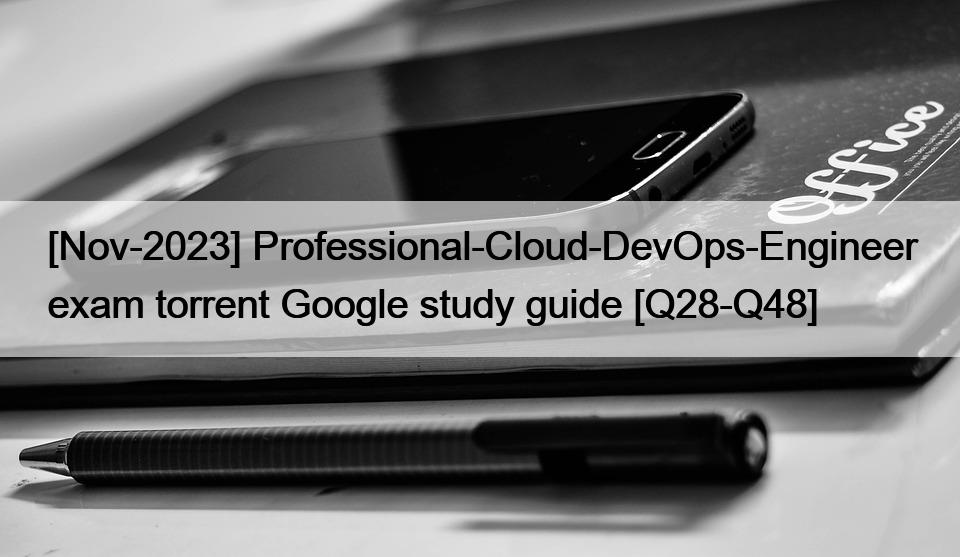[Nov-2023] Professional-Cloud-DevOps-Engineer exam torrent Google study guide [Q28-Q48]

[Nov-2023] Professional-Cloud-DevOps-Engineer exam torrent Google study guide
Use Valid New Professional-Cloud-DevOps-Engineer Test Notes & Professional-Cloud-DevOps-Engineer Valid Exam Guide
Google Professional-Cloud-DevOps-Engineer certification exam is a highly coveted credential for professionals who want to demonstrate their expertise in cloud DevOps engineering. Google Cloud Certified – Professional Cloud DevOps Engineer Exam certification exam is designed to test the candidate’s knowledge and skills in various cloud-based DevOps tools and technologies, including infrastructure automation, continuous integration and delivery, monitoring and logging, and security and compliance.
Google Professional-Cloud-DevOps-Engineer exam is a challenging exam that requires candidates to have a strong understanding of DevOps engineering practices and Google Cloud technologies. To prepare for the exam, candidates should have a solid understanding of the topics covered in the exam, such as continuous delivery, automation, infrastructure as code, and monitoring. They should also have hands-on experience with Google Cloud technologies and related DevOps tools and practices.
![]()
Professional-Cloud-DevOps-Engineer Exam questions and answers: https://www.topexamcollection.com/Professional-Cloud-DevOps-Engineer-vce-collection.html
Professional-Cloud-DevOps-Engineer Practice Tests
Related Certifications
Recent Posts
- [2025] Pass PL-300 Exam – Real Questions & Answers [Q87-Q106]
- Pass Linux Foundation CKA Exam Quickly With TopExamCollection [Q58-Q82]
- Free ECCouncil 212-82 Test Practice Test Questions Exam Dumps [Q18-Q42]
- Pass Adobe AD0-E906 Exam with Guarantee Updated 57 Questions [Q19-Q34]
- 100% PASS RATE VMCE VMCE_v12 Certified Exam DUMP with 132 Questions [Q76-Q91]
Recent Comments
Categories
- AAPC
- ACAMS
- ACFE
- Admission Tests
- Adobe
- AFP
- AHIMA
- Amazon
- American College of Rheumatology
- API
- APICS
- APMG-International
- ASQ
- ATLASSIAN
- Avaya
- BCS
- BICSI
- Business Architecture Guild
- CAA Global
- CFA Institute
- CheckPoint
- CIMA
- CIPS
- Cisco
- Citrix
- CIW
- Cloud Security Alliance
- Cloudera
- CompTIA
- Confluent
- Copado
- CPA Australia
- CREST
- CrowdStrike
- CyberArk
- Databricks
- DSCI
- EC-COUNCIL
- ECCouncil
- EMC
- EXIN
- F5
- FINRA
- Fortinet
- FSMTB
- GAQM
- Genesys
- GIAC
- H3C
- HAAD
- HashiCorp
- HDI
- Hitachi
- HP
- Huawei
- IAPP
- IBM
- IFSE Institute
- IIBA
- ISACA
- ISC
- ISQI
- ITIL
- Juniper
- Lenovo
- Linux Foundation
- Lpi
- Microsoft
- MikroTik
- MongoDB
- MuleSoft
- NACE
- NCLEX
- Netskope
- NetSuite
- Network Appliance
- NMLS
- Nokia
- Nutanix
- OCEG
- Okta
- OMG
- Oracle
- OutSystems
- Palo Alto Networks
- PCI
- PDMA
- PECB
- Pegasystems
- Peoplecert
- PMI
- PRINCE2
- Protocol Analysis
- Python Institute
- Qlik
- RedHat
- Salesforce
- SAP
- SASInstitute
- Scaled Agile
- Scrum
- ServiceNow
- Shared Assessments
- Snowflake
- Splunk
- Symantec
- Tableau
- The Open Group
- UiPath
- Veeam
- VMware





